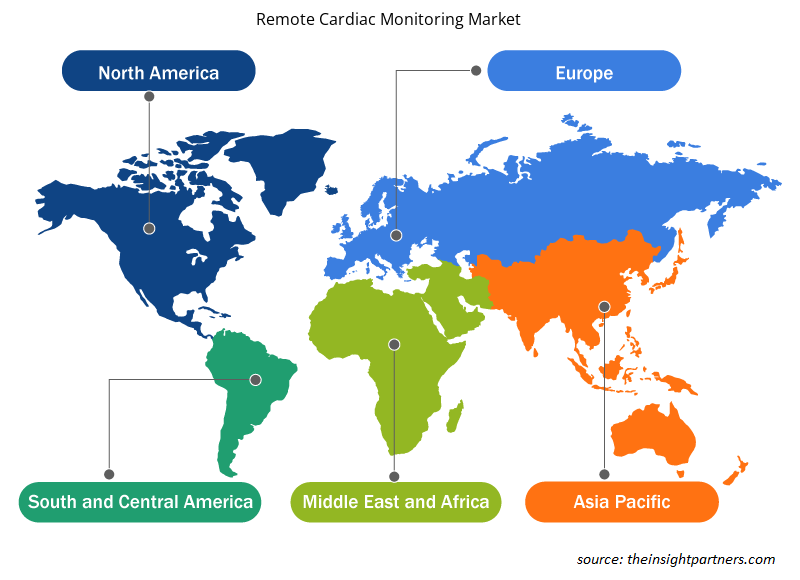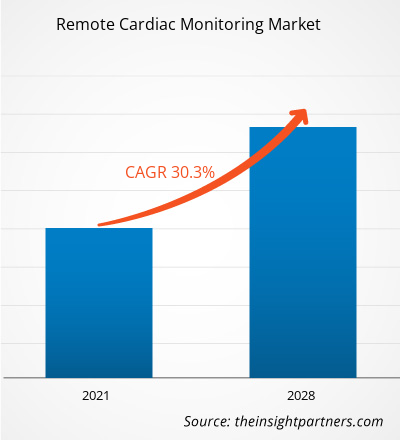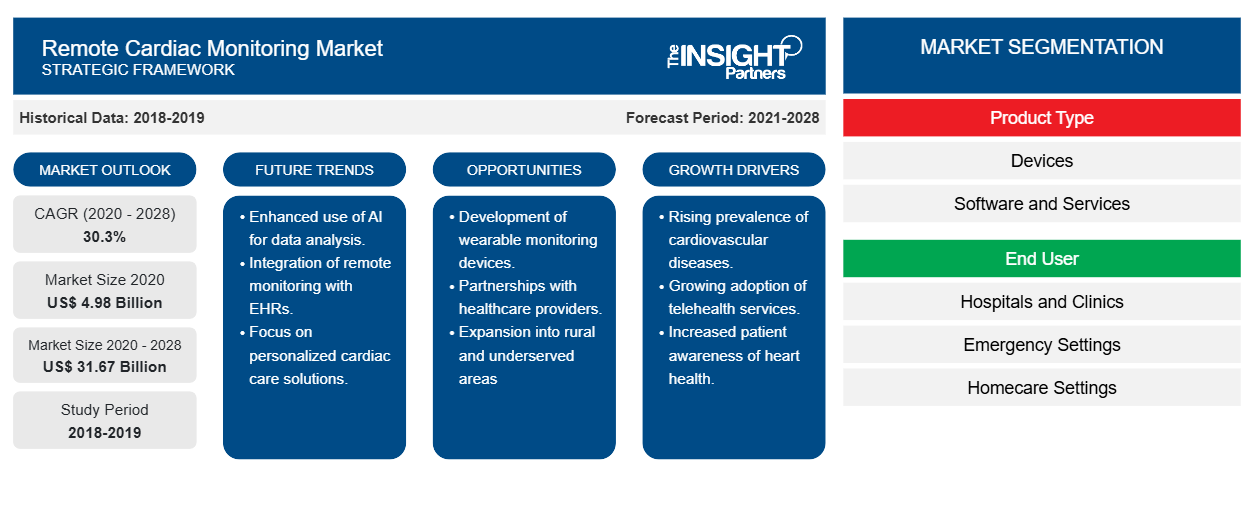Der Markt für die Fernüberwachung der Herzfunktion soll von 4.976,40 Millionen US-Dollar im Jahr 2021 auf 31.671,69 Millionen US-Dollar im Jahr 2028 anwachsen; von 2021 bis 2028 wird mit einer durchschnittlichen jährlichen Wachstumsrate von 30,3 % gerechnet.
Geräte zur Fernüberwachung des Herzens ermöglichen eine kontinuierliche Überwachung der elektrischen Aktivitäten des Herzens auch außerhalb von Krankenhäusern. Sie ermöglichen auch die Überwachung per Elektrokardiogramm (EKG) zu Hause bei Patienten mit Verdacht auf Herzrhythmusstörungen oder bei denen das Risiko besteht, dass diese auftreten. Die Überwachung kann auch durchgeführt werden, wenn die Patienten mit ihren täglichen Aktivitäten beschäftigt sind. Einer der wichtigsten Vorteile der Fernüberwachung des Herzens durch Geräte besteht daher darin, dass sie die Notwendigkeit routinemäßiger Arztbesuche verringert. Geräte wie Herzschrittmacher und implantierbare Kardioverter-Defibrillatoren werden in minimalinvasiven Verfahren in das Herz des Patienten implantiert. Ein Sender, der synchron mit dem Gerät arbeitet, übernimmt die Datenübertragung. Faktoren wie die Zunahme von Herz-Kreislauf-Erkrankungen und kontinuierliche Entwicklungen im Bereich der Telemedizin fördern das Wachstum des Marktes für die Fernüberwachung des Herzens . Bedenken hinsichtlich des Datenschutzes hemmen jedoch das Marktwachstum.
Passen Sie diesen Bericht Ihren Anforderungen an
Sie erhalten kostenlos individuelle Anpassungen an jedem Bericht, einschließlich Teilen dieses Berichts oder einer Analyse auf Länderebene, eines Excel-Datenpakets sowie tolle Angebote und Rabatte für Start-ups und Universitäten.
-
Holen Sie sich die wichtigsten Markttrends aus diesem Bericht.Dieses KOSTENLOSE Beispiel umfasst eine Datenanalyse von Markttrends bis hin zu Schätzungen und Prognosen.
Markteinblicke
Zunahme von Herz-Kreislauf-Erkrankungen
Durch Patientenfernüberwachung (RPM) können Patienten ihre Gesundheit besser kontrollieren, indem sie sich stärker an ihrer Gesundheitsversorgung beteiligen. Die American Heart Association unterstützt Initiativen, die die Entwicklung und Nutzung evidenzbasierter Technologien zur Patientenfernüberwachung fördern. Laut der Weltgesundheitsorganisation (WHO) gehören Herz-Kreislauf-Erkrankungen (CVDs) zu den häufigsten Todesursachen weltweit, und jedes Jahr erleiden etwa 30 Millionen Menschen einen Schlaganfall. Laut der American Heart Association leidet fast die Hälfte aller Erwachsenen in den USA an einer Art von CVD. Darüber hinaus werden bis 2035 voraussichtlich mehr als 130 Millionen Menschen, d. h. 45,1 % der US-Bevölkerung, an einer Art von CVD leiden. Berichten der European Society of Cardiology zufolge verursachen CVDs in Europa 3,9 Millionen Todesfälle und in der Europäischen Union (EU) über 1,8 Millionen Todesfälle. Darüber hinaus sind sie für 45 % aller Todesfälle in Europa und 37 % aller Todesfälle in der EU verantwortlich. Die durch Herz-Kreislauf-Erkrankungen verursachten Todesfälle in den Ländern des asiatisch-pazifischen Raums reichen von weniger als 20 % in Ländern wie Thailand, den Philippinen und Indonesien bis zu 20–30 % in den Städten Chinas, Hongkongs, Japans, Koreas und Malaysias. Darüber hinaus weisen Neuseeland, Australien und Singapur, um nur einige zu nennen, relativ hohe Raten von 30–35 % auf.
Bluthochdruck ist ein erheblicher Risikofaktor für Herz-Kreislauf-Erkrankungen. Die altersbereinigte Prävalenz von Bluthochdruck unter Erwachsenen in den USA beträgt ~35 %, was einer Bevölkerung von ~85 Millionen entspricht. Bis 2035 werden ~42 % der Erwachsenen des Landes, also weitere 27 Millionen, an dieser Krankheit leiden. Die Kostenbelastung durch Bluthochdruck für die Volkswirtschaften steigt ebenfalls und die Kosten werden wahrscheinlich von ~70 Milliarden US-Dollar im Jahr 2015 auf ~150 Milliarden US-Dollar bis 2035 steigen. Die Fernüberwachung von Patienten kann ein wichtiger Weg sein, um die Kontrolle des Bluthochdrucks zu verbessern und die wirtschaftliche Belastung durch längere oder häufige Krankenhausaufenthalte infolge akuter Ereignisse im Zusammenhang mit Bluthochdruck zu verringern. Untersuchungen haben gezeigt, dass RPM (Fernüberwachung von Patienten) den systolischen Blutdruck (SBP) und den diastolischen Blutdruck (DBP) im Vergleich zur üblichen Behandlung und Selbstüberwachung allein deutlich senken kann. Laut einigen nicht randomisierten Studien können RPM-Geräte die Ergebnisse verbessern, indem sie eine genaue und frühzeitige Erkennung ermöglichen und die Gesamtmortalitätsrate sowie die Zahl der Krankenhausaufenthalte senken. Aktuelle klinische Richtlinien empfehlen dringend den Einsatz von RPM zur Erkennung von Vorhofflimmern (AF) sowohl bei Schlaganfall- als auch bei Nicht-Schlaganfallpatienten.
Produkttypbasierte Einblicke
Basierend auf dem Produkttyp ist der Markt für die Fernüberwachung des Herzens weiter in Geräte, Software und Dienste unterteilt. Das Gerätesegment hatte 2021 einen größeren Marktanteil und dürfte im Prognosezeitraum eine höhere CAGR verzeichnen.
Endbenutzerbasierte Erkenntnisse
Basierend auf dem Endnutzer ist der Markt für die Fernüberwachung des Herzens in Krankenhäuser und Kliniken, Notfalleinrichtungen, häusliche Pflegeeinrichtungen und andere unterteilt. Das Segment Krankenhäuser und Kliniken würde 2021 den größten Marktanteil halten, während der Markt für das Segment Notfalleinrichtungen im Prognosezeitraum voraussichtlich mit einer durchschnittlichen jährlichen Wachstumsrate von 31,60 % wachsen wird.
Verschiedene auf dem Markt für die Fernüberwachung der Herzfunktion tätige Unternehmen verfolgen Strategien wie Produkteinführungen, Fusionen und Übernahmen, Kooperationen, Produktinnovationen und die Erweiterung ihres Produktportfolios, um ihre Präsenz weltweit auszubauen, ihren Markennamen zu wahren und die wachsende Nachfrage der Endbenutzer zu erfüllen.
Regionale Einblicke in den Markt für Fernüberwachung des Herzens
Die regionalen Trends und Faktoren, die den Markt für Herzfernüberwachung im Prognosezeitraum beeinflussen, wurden von den Analysten von Insight Partners ausführlich erläutert. In diesem Abschnitt werden auch Marktsegmente und Geografie für Herzfernüberwachung in Nordamerika, Europa, im asiatisch-pazifischen Raum, im Nahen Osten und Afrika sowie in Süd- und Mittelamerika erörtert.

- Erhalten Sie regionale Daten zum Markt für Herzfernüberwachung
Umfang des Marktberichts zur Fernüberwachung des Herzens
| Berichtsattribut | Details |
|---|---|
| Marktgröße im Jahr 2020 | 4,98 Milliarden US-Dollar |
| Marktgröße bis 2028 | 31,67 Milliarden US-Dollar |
| Globale CAGR (2020 - 2028) | 30,3 % |
| Historische Daten | 2018-2019 |
| Prognosezeitraum | 2021-2028 |
| Abgedeckte Segmente |
Nach Produkttyp
|
| Abgedeckte Regionen und Länder |
Nordamerika
|
| Marktführer und wichtige Unternehmensprofile |
|
Marktteilnehmerdichte: Der Einfluss auf die Geschäftsdynamik
Der Markt für Remote Cardiac Monitoring wächst rasant, angetrieben durch die steigende Nachfrage der Endnutzer aufgrund von Faktoren wie sich entwickelnden Verbraucherpräferenzen, technologischen Fortschritten und einem größeren Bewusstsein für die Vorteile des Produkts. Mit steigender Nachfrage erweitern Unternehmen ihr Angebot, entwickeln Innovationen, um die Bedürfnisse der Verbraucher zu erfüllen, und nutzen neue Trends, was das Marktwachstum weiter ankurbelt.
Die Marktteilnehmerdichte bezieht sich auf die Verteilung der Firmen oder Unternehmen, die in einem bestimmten Markt oder einer bestimmten Branche tätig sind. Sie gibt an, wie viele Wettbewerber (Marktteilnehmer) in einem bestimmten Marktraum im Verhältnis zu seiner Größe oder seinem gesamten Marktwert präsent sind.
Die wichtigsten auf dem Markt für die Fernüberwachung der Herzfunktion tätigen Unternehmen sind:
- OSI Systems, Inc.
- GE-Gesundheitswesen
- Biotronik Se
- Nihon Kohden Corporation
- Abbott Laboratories
Haftungsausschluss : Die oben aufgeführten Unternehmen sind nicht in einer bestimmten Reihenfolge aufgeführt.

- Überblick über die wichtigsten Akteure auf dem Markt für Herzfernüberwachung
Markt für Herzfernüberwachung – nach Produkttyp
- Geräte
- Software
- Dienstleistungen
Markt für Remote-Herzüberwachung – nach Endbenutzer
- Krankenhäuser und Kliniken
- Notfalleinstellungen
- Einstellungen für die häusliche Pflege
- Sonstiges
Markt für Herzfernüberwachung – nach Geografie
-
Nordamerika
- UNS
- Kanada
- Mexiko
-
Europa
- Frankreich
- Deutschland
- Italien
- Vereinigtes Königreich
- Spanien
- Restliches Europa
-
Asien-Pazifik (APAC)
- China
- Indien
- Südkorea
- Japan
- Australien
- Restlicher Asien-Pazifik-Raum
-
Naher Osten und Afrika (MEA)
- Südafrika
- Saudi-Arabien
- Vereinigte Arabische Emirate
- Restlicher Naher Osten und Afrika
-
Süd- und Mittelamerika (SCAM)
- Brasilien
- Argentinien
- Restliches Süd- und Mittelamerika
Firmenprofile
- OSI Systems, Inc.
- GE-Gesundheitswesen
- Biotronik Se
- Nihon Kohden Corporation
- Abbott Laboratories
- Boston Scientific ist eine gemeinnützige Organisation, die sich auf die Förderung von Wissenschaft und Technologie spezialisiert hat. Sie ist die erste in den USA und hat 19
- Koninklijke Philips NV
- Honeywell International, Inc.
- AMC Gesundheit
- Historische Analyse (2 Jahre), Basisjahr, Prognose (7 Jahre) mit CAGR
- PEST- und SWOT-Analyse
- Marktgröße Wert/Volumen – Global, Regional, Land
- Branchen- und Wettbewerbslandschaft
- Excel-Datensatz
Aktuelle Berichte
Erfahrungsberichte
Grund zum Kauf
- Fundierte Entscheidungsfindung
- Marktdynamik verstehen
- Wettbewerbsanalyse
- Kundeneinblicke
- Marktprognosen
- Risikominimierung
- Strategische Planung
- Investitionsbegründung
- Identifizierung neuer Märkte
- Verbesserung von Marketingstrategien
- Steigerung der Betriebseffizienz
- Anpassung an regulatorische Trends























 Kostenlose Probe anfordern für - Markt für Fernüberwachung des Herzens
Kostenlose Probe anfordern für - Markt für Fernüberwachung des Herzens